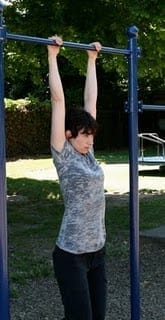


Here I am hanging on the monkey bars. Can you tell the difference between the three photos? The first photo I’m rib thrusting. Notice anything else? I don’t have a neck! My lats are so weak that my shoulders raise up around my ears.
I’ve been a chronic rib thruster most of my life. It’s a way for us to hide the hunch back (hyperkyphosis) in our thoracic spine. You may think you are correcting your alignment by thrusting, but every time you lift your chest to “stand up straight” (think military stance) you shear your vertebrae which will lead to a decrease in bone density in the area. The vertebrae are one of the four main areas in our body where we develop osteoporosis, the others are the wrists, head of the femurs and the ribs. Ribcage thrusting also causes unnecessary stress to your nervous system. What runs through the vertebrae? The spinal cord!
The second photo shows me in hip flexion indicating a shortening of the lower psoas. This indicates that a person is a chronic tailbone tucker. Here is a video Katy Bowman did to demonstrate tucked vs untucked pelvis.
The third photo is me pulling my ribs down (as best I can) and relaxing my psoas.
The one thing these three photos have in common is that I’m biting my lower lip. It’s interesting to see where we hold stress in your bodies while hanging or doing balancing poses.








Bravo Barbara! The photos and the accompanying explanation is very well done. Nice touch adding the link to Katy’s untucking video. Gotta go hang on the bars at my local park!
Ditto, to Tims comment, Nicely Done Barbara!! The link to Katy’s video isn’t showing as I’m reading this though??
Thanks guys. When you click on the link it will take you to Katy’s blog to view it.
I love the monkey bars! Great work Barbara!!
Really enjoyed reading your blog. This is the first I’ve seen of your work but will continue to peruse about your archives. I’d also never seen Katy’s “tucked / untucked” sitting video and cracked-up… had to watch it again. Thank you both for all that you do.
Thank you! I’m just getting started, but plan on posting once or twice a every week. I had to giggle watching Katy’s tuck/untuck video as well, she’s hilarious.
So, if I try to hang but just hanging feels like my arms are ripping out of my sockets and then I’m so sore that I can’t lift my arms above a certain point for a week, what am I doing wrong? Or should it hurt?
This was after hanging 3 times per day for 2 days for about 20 seconds each time.
Thanks for your answer :).
Hi Melissa, My guess is that your shoulder girdle is so tight that when you hang it pushes you beyond your range of motion. You may want to start with Katy Bowman’s one hour shoulder girdle class, you can take it online. Here’s the link
Thank you for the class link, I’ll give it a try. I feel really silly when my 2 year old can hang longer than I can!
I know the feeling-when kids at the playground see me hanging or crossing the monkey bars they imitate me with such ease. That’s the cool thing about kids, the more they see you being active, the more active they will be and by doing so maybe they won’t lose that strength like we did.
Barabara, I’ve been reading about Katy Bowman for a few days now since I am home sick. (I came across your fantastic web site via her Facebook page.) I have a question for you: I am an aspiring belly dancer, which means as much as I practice I am both thrusting out my chest and tucking my pelvis under. Exactly what I shouldn’t be doing, correct? Thank you for any advice.
What kind of monkey bars workout do you recommend to help release the psoas?
Hi Max, I don’t know of a monkey bar workout to release the psoas. This article was more of a demonstration to reveal areas of restriction. You may want to read my post on the psoas for tips. https://alignmentmonkey.nurturance.net/2011/the-psoas-muscle/